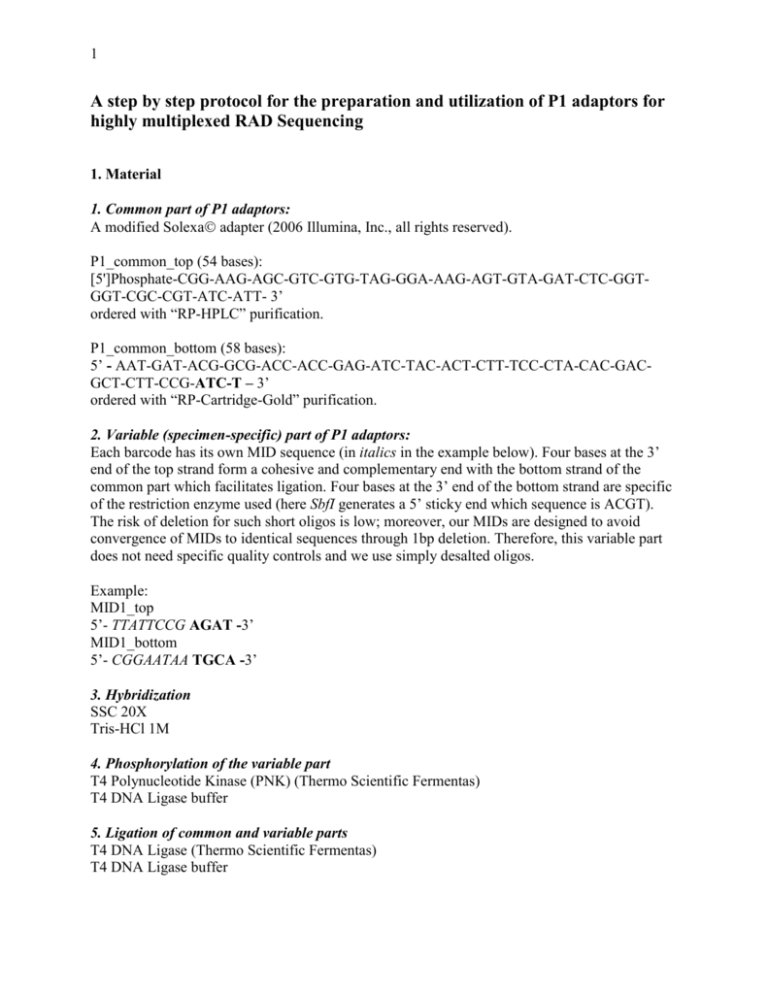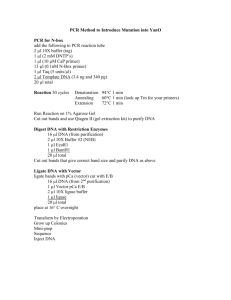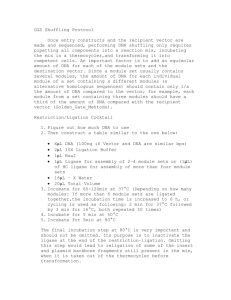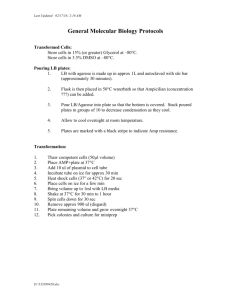
1
A step by step protocol for the preparation and utilization of P1 adaptors for
highly multiplexed RAD Sequencing
1. Material
1. Common part of P1 adaptors:
A modified Solexa adapter (2006 Illumina, Inc., all rights reserved).
P1_common_top (54 bases):
[5']Phosphate-CGG-AAG-AGC-GTC-GTG-TAG-GGA-AAG-AGT-GTA-GAT-CTC-GGTGGT-CGC-CGT-ATC-ATT- 3’
ordered with “RP-HPLC” purification.
P1_common_bottom (58 bases):
5’ - AAT-GAT-ACG-GCG-ACC-ACC-GAG-ATC-TAC-ACT-CTT-TCC-CTA-CAC-GACGCT-CTT-CCG-ATC-T – 3’
ordered with “RP-Cartridge-Gold” purification.
2. Variable (specimen-specific) part of P1 adaptors:
Each barcode has its own MID sequence (in italics in the example below). Four bases at the 3’
end of the top strand form a cohesive and complementary end with the bottom strand of the
common part which facilitates ligation. Four bases at the 3’ end of the bottom strand are specific
of the restriction enzyme used (here SbfI generates a 5’ sticky end which sequence is ACGT).
The risk of deletion for such short oligos is low; moreover, our MIDs are designed to avoid
convergence of MIDs to identical sequences through 1bp deletion. Therefore, this variable part
does not need specific quality controls and we use simply desalted oligos.
Example:
MID1_top
5’- TTATTCCG AGAT -3’
MID1_bottom
5’- CGGAATAA TGCA -3’
3. Hybridization
SSC 20X
Tris-HCl 1M
4. Phosphorylation of the variable part
T4 Polynucleotide Kinase (PNK) (Thermo Scientific Fermentas)
T4 DNA Ligase buffer
5. Ligation of common and variable parts
T4 DNA Ligase (Thermo Scientific Fermentas)
T4 DNA Ligase buffer
2
6. SbfI digestion of genomic DNA
Sbf I – HF (NEB)
NEB Buffer 4
7. P1 adaptor ligation
T4 DNA Ligase (Thermo Scientific Fermentas)
T4 DNA Ligase buffer
8. Fill-in
Bst 2.0 warm start DNA polymerase (NEB)
Isothermal amplification buffer
2. Methods
The different steps are schematized in figure 1. In this study, we tested two types of adaptors but
since the new, unphosphorylated adaptors (avoiding P1-P1 ligation) give best results, we only
provide details here on how to produce this version.
1. Synthesis of the different parts of P1 adaptors (fig 1 A - C)
The common part of P1 adaptors is synthetized only once, with 5’ phosphate modification for the
top strand. The variable part is synthetized as many times as there are samples to be multiplexed,
each with its own sequence.
2. Hybridization of the two strands of the common part (fig 1 C)
Prepare double-stranded common part of the adaptor in a 1 mL reaction volume (for 100
adaptors) containing 860 µL H20, 100 µL of SSC (20X), 10 µL of Tris-HCl (1M) and 15 µL of
each strand (100µM) to obtain a final concentration of 1.5µM each. Denature for 5 min at 92 °C
and let cool down slowly at room temperature for 1 hour.
3. Phosphorylation of the variable part of P1 adaptors (fig 1 B)
This step adds a phosphate group to the 5’ end of the variable part that is necessary for the ligase
in a subsequent step. We do this only for the bottom strand and let the top strand
unphosphorylated.
T4 DNA ligase buffer is used in the phosphorylation reactions in this protocol instead of
PNK buffer because this buffer is directly compatible, without purification, with the ligation that
comes after. This buffer contains ATP therefore it is not necessary to add more.
For each adaptor, prepare in a 20 µL reaction volume a mix with 7 µL H20, 2 µL of T4 DNA
ligase buffer (10X), 1 µL of PNK (10U/µL) and 10 µL of the bottom strand (100 µM) to obtain a
final concentration of 50 µM. Incubate for 1 h at 37 °C then inactivate PNK for 10 min at 75 °C.
4. Hybridization of the two strands of the variable part (fig 1 B)
Prepare double-stranded variable part of the adaptor the same way as in step 2, but individually
for each barcode. Mix together 140.7 µL H20, 16.65 µL of SSC (20X), 1.65 µL of Tris-HCl
(1M), 5 µL of the bottom strand phosphorylated at step 3 (50 µM) and 2.5 µL of the top strand
3
unphosphorylated (100 µM). This way you obtain double-stranded variable part of the adaptor at
1.5 µM. Denature for 5 min at 92 °C and let cool down slowly at room temperature for 1 hour.
5. Ligation of the common part with the variable part of P1 adaptors (fig 1 E)
The two parts of the adaptors are ligated together with T4 DNA ligase to produce complete
adaptors at 0.5 µM. For each adaptor, prepare a 30 µL reaction volume containing 6 µL H20, 3
µL of T4 DNA ligase buffer (10X), 1 µL of T4 DNA ligase (5 U/µL), 10 µL of double-stranded
common part (1.5 µM) and 10 µL of double-stranded variable part (1.5 µM).
6. DNA extraction and quantification
In this study, we tested many samples that were prepared by different ways. Some of them were
extracted and purified with phenol-chloroform procedure and treated with RNase A while others
were purified with an affinity column (DNeasy kit from Qiagen), treated or not with RNase A.
DNA concentrations were measured by fluorometry using Picogreen (Invitroen).
7. Digestion of genomic DNA
Different amounts of genomic DNA were used depending on the samples, ranging from 3 to 152
ng (table X). If necessary, DNA samples were diluted with water to produce 10 µL with
appropriate concentration. Genomic DNA were digested in a 20 µL reaction volume containing 7
µL H20, 2 µL of NEB buffer 4 (10X) and 1 µL of SbfI (5 U/µL). Reactions were incubated for 3
h at 37 °C then SbfI was inactivated for 20 min at 65 °C, following manufacturer’s
recommendations.
8. P1 adaptor ligation (fig 1 E)
For ligation reactions, add 1 µL of P1 adaptor (0.5 µM) to digested DNA (20µL) then add a mix
composed of 28 µL H20, 6 µL of T4 DNA ligase buffer (10X) and 5 µL of T4 DNA ligase (5
U/µL). Incubate for 2 h at 23 °C then inactivate ligase for 30 min at 65 °C, and let cool down
slowly for 1 hour at room temperature.
9. Fill-in reaction (fig 1 F)
As these adaptors do not have any phosphate at the 5’ end, the ligation to SbfI-digested genomic
DNA relies on a single phosphate provided by the genomic DNA. The resulting nick on the top
strand needs to be filled in a 120 µL reaction volume by adding to the ligation reaction (step 8)
28 µL H20, 12 µL of isothermal amplification buffer (10X), 2 µL of dNTP (10 mM) and 4 µL of
Bst 2.0 polymerase (8 U/µL). Incubate reactions for 1 h at 65 °C, then inactivate the polymerase
for 20 min at 80 °C.









